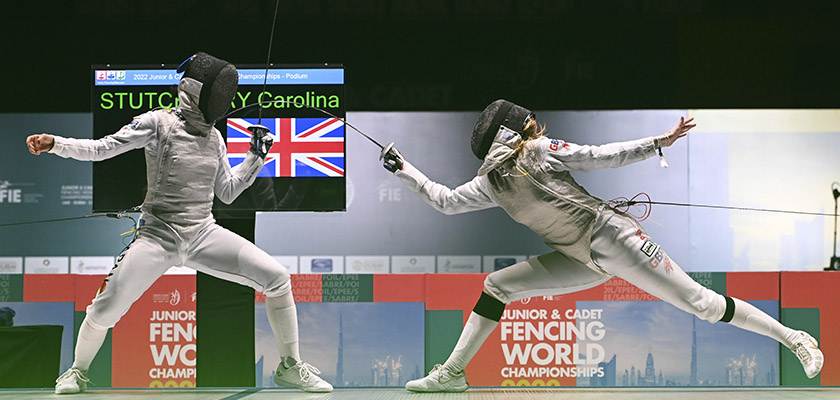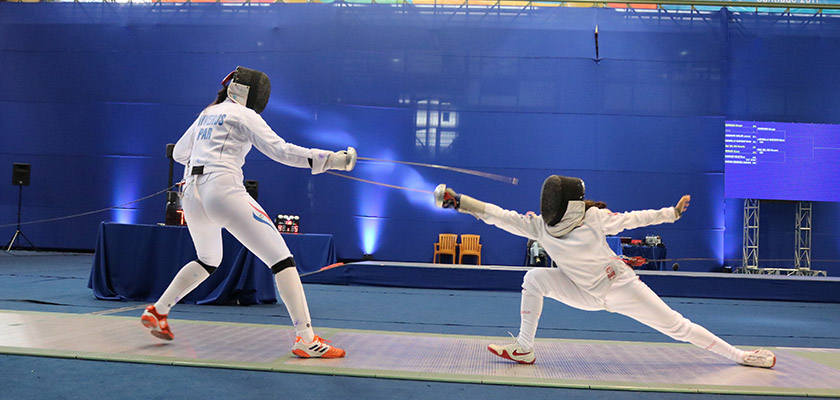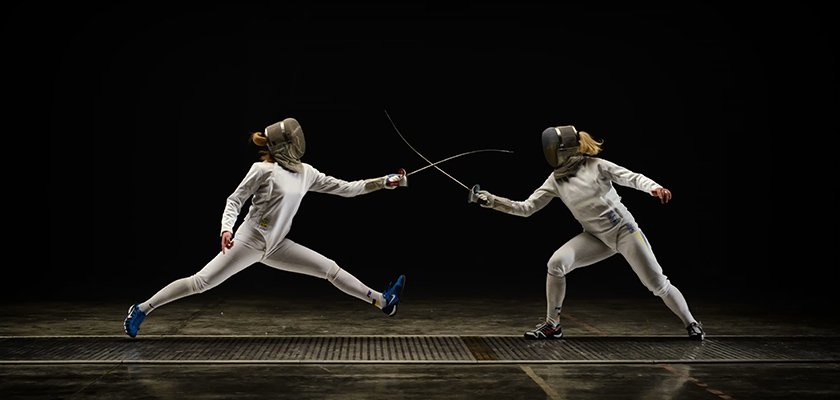Fencing is a combat sport that involves the use of bladed weapons such as swords, foils and sabres to attack and defend against opponents.
It is one of the oldest and most traditional disciplines in the Olympic Games, having been played since the first edition in 1896.
Curious to know how this much-loved sport works? Then we’ve got great news for you: you’ve come to the right place!
In this complete and up-to-date guide, we’ll introduce you to the history, disciplines, rules and basic concepts of fencing.
Check it out 👇
History of fencing
The history of fencing dates back to ancient times, when the practice of combat with melee weapons was essential for survival and self-defence. This skill evolved over the centuries, especially during the Middle Ages and the Renaissance, when warfare was a constant practice on the planet.
In the Middle Ages, fencing was a fundamental skill for knights, who mastered the use of swords, lances and other weapons in battle.
With the Renaissance, there was a resurgence of interest in martial arts and the development of combat techniques. This period saw the emergence of the first fencing schools in Europe.
The 17th century marked a significant turning point in the history of fencing, with the development of a formal system of techniques and rules.
The creation of fencing treatises, such as Girard Thibault’s “Livre d’escrime” (1628) and Ridolfo Capo Ferro’s “Treatise on the Sword” (1610), contributed to the standardisation and dissemination of the sport.
In the 18th century, fencing became a more refined and socially valued activity, with the introduction of more elaborate rules and the use of protective equipment so that athletes wouldn’t get hurt.
Fencing academies flourished throughout Europe, where nobles and aristocrats practised the art of fencing as a form of entertainment.
During the 19th century, fencing underwent a series of significant changes, with the introduction of new weapons and techniques. The foil, sword and sabre became the three standard weapons of competitive sport, each with its own rules and combat styles.
The 20th century saw fencing become an internationally recognised sport, with the founding of the International Fencing Federation (FIE).
Modern competitive fencing is now an Olympic sport, with exciting competitions attracting athletes from all over the world.
How does a fencing duel work?

Before the duel begins, the fencers prepare themselves by checking their protective equipment and weapons. Then they greet each other and take up their positions on the combat floor. As soon as the referee gives the signal, the fencers start moving and duelling.
During the match, they try to score points by touching their opponent with the tips of their weapons, following the rules of the specific sport. The points are recorded by the referee or by an electronic scoring system.
The duel continues until one of the fencers reaches a predetermined number of points or until the designated time for the duel expires.
If there is more than one round, the fencers have a short break between them to rest and receive guidance from the coaches.
In this context, the bout ends when all rounds have been completed, and the fencer with the most points is declared the winner.
In the event of a tie, additional rounds can be held until one fencer gains a decisive advantage. Throughout the competition, the referee ensures compliance with the rules and the safety of the fencers.
Fencing disciplines
In fencing, there are three main categories, each associated with a specific weapon and a unique set of rules and techniques.They are:
- The foil is one of the three weapons used in competitive fencing. It is a light, flexible weapon with a straight blade and tapered tip, used mainly for precision fencing. In foil, points can only be scored by touching the opponent with the tip of the blade, and only the torso is considered a valid scoring area;
- Sword | The sword is another weapon used in competitive fencing. It is slightly heavier than the foil, with a straight blade and a sharp point. Unlike the foil, with the sword, points can be scored with both the tip and the edges of the blade. In addition, the entire body is considered a valid area for scoring points, making the sword a more versatile weapon in terms of targets;
- Sabre | The sabre is the third weapon in competitive fencing. It has a curved blade and a sharp point, designed to simulate cavalry blows. In sabre, points can be scored with the tip of the blade as well as the edges. The area valid for scoring points includes everything above the waist, including the head, torso and arms.
Fencing disciplines at the Olympics
- Men’s individual sword
- Men’s team sword
- Women’s individual sword
- Women’s team sword
- Men’s individual foil
- Men’s team foil
- Women’s individual foil
- Women’s team foil
- Men’s individual sabre
- Men’s team sabre
- Women’s individual sabre
- Women’s team sabre
Fencing rules – Foil

In this sport, fencers aim to touch their opponent with the tip of the foil while dodging their opponent’s attacks.
The valid scoring area is the opponent’s torso, from the shoulders to the groin, including the torso and neck, while limbs are not considered.
The concept of “priority” is fundamental: the fencer who initiates a valid attack has the right of attack, and if both attack simultaneously, the fencer with priority is awarded the point.
Diversions are often used to avoid attacks and create counter-attack opportunities. In addition, controlling time is crucial to creating openings and avoiding being hit.
There are several possible fouls, such as touching outside the valid area or using the non-pointed side of the foil, subject to penalties that can include warnings, points for the opponent or even disqualification.
Fencing rules – Sword
In this category, the fencers’ main objective is to touch their opponent with the tip of their sword. Unlike foil, where only the torso is considered a valid target, in swordfighting the entire length of the body is considered a scoring area.
A valid touch is scored when the tip of the sword makes contact with any part of the opponent’s body. Therefore, there is no concept of “priority” as in foil.
Fouls and penalties follow similar rules, with fencers subject to penalties for unsportsmanlike behaviour, touches outside the valid area or any violation of the sport’s rules.
Fencing rules – Sabre
In this category, the main objective is to touch the opponent with the sabre blade, either through cuts or thrusts, while avoiding being touched.
Unlike foil and sword, where specific areas of the body are targeted, in sabre, any part above the waist is considered valid for scoring, including the head, torso and arms.
A valid touch is registered when the sabre blade makes contact with the opponent’s valid area with the necessary force. Compared to foil, priority is less emphasised in sabre.
Fouls and penalties follow similar rules to the other disciplines, with punishments for unethical behaviour, touches outside the valid area and other violations of the sport’s rules.
Fencing equipment

- White weapon | Depending on the discipline practised (foil, sword or sabre), fencers use a specific weapon. Each one has its own unique characteristics according to the rules of the category;
- Protective jacket | A special jacket, usually made of puncture-resistant fabric, is used to protect the fencer’s torso and arms from possible blows;
- Mask | In duels, athletes wear a sturdy metal mask that covers the fencer’s face, protecting him from direct blows. The mask has a grid that allows vision and proper breathing;
- Gloves | Padded or reinforced gloves, usually made of leather or synthetic materials, are used to protect the hand holding the weapon;
- Trousers | In duels, athletes equip themselves with trousers made of resistant fabric that cover the fencer’s legs, offering additional protection against blows;
- Shoes | Shoes specially designed for fencing, which offer stability, grip and mobility during fast and agile movements on the track, are used in combat.
Now that you know all about fencing, you can follow the duels at the Olympics and cheer on your favourite athlete! And don’t forget: for more content on sports, keep following us daily 👊



